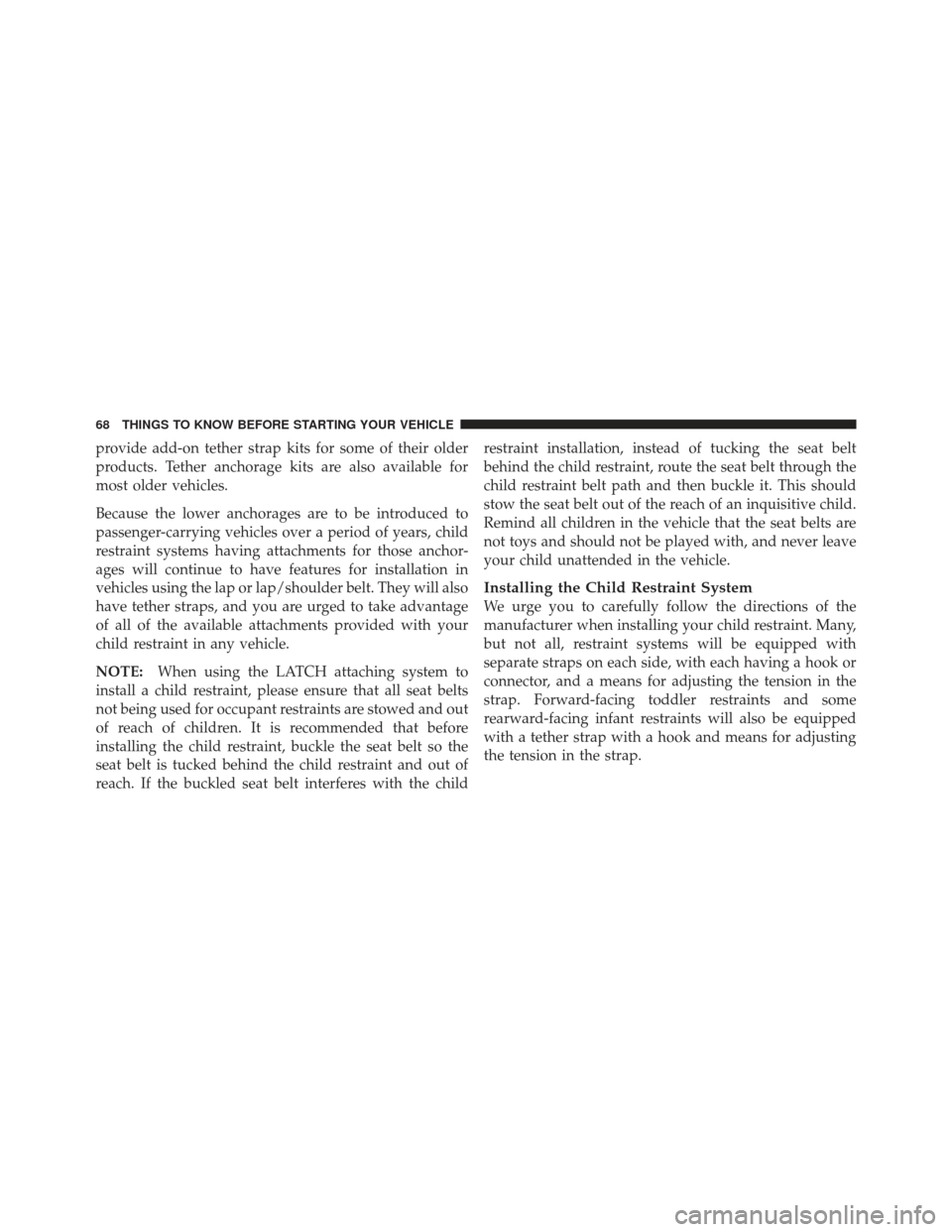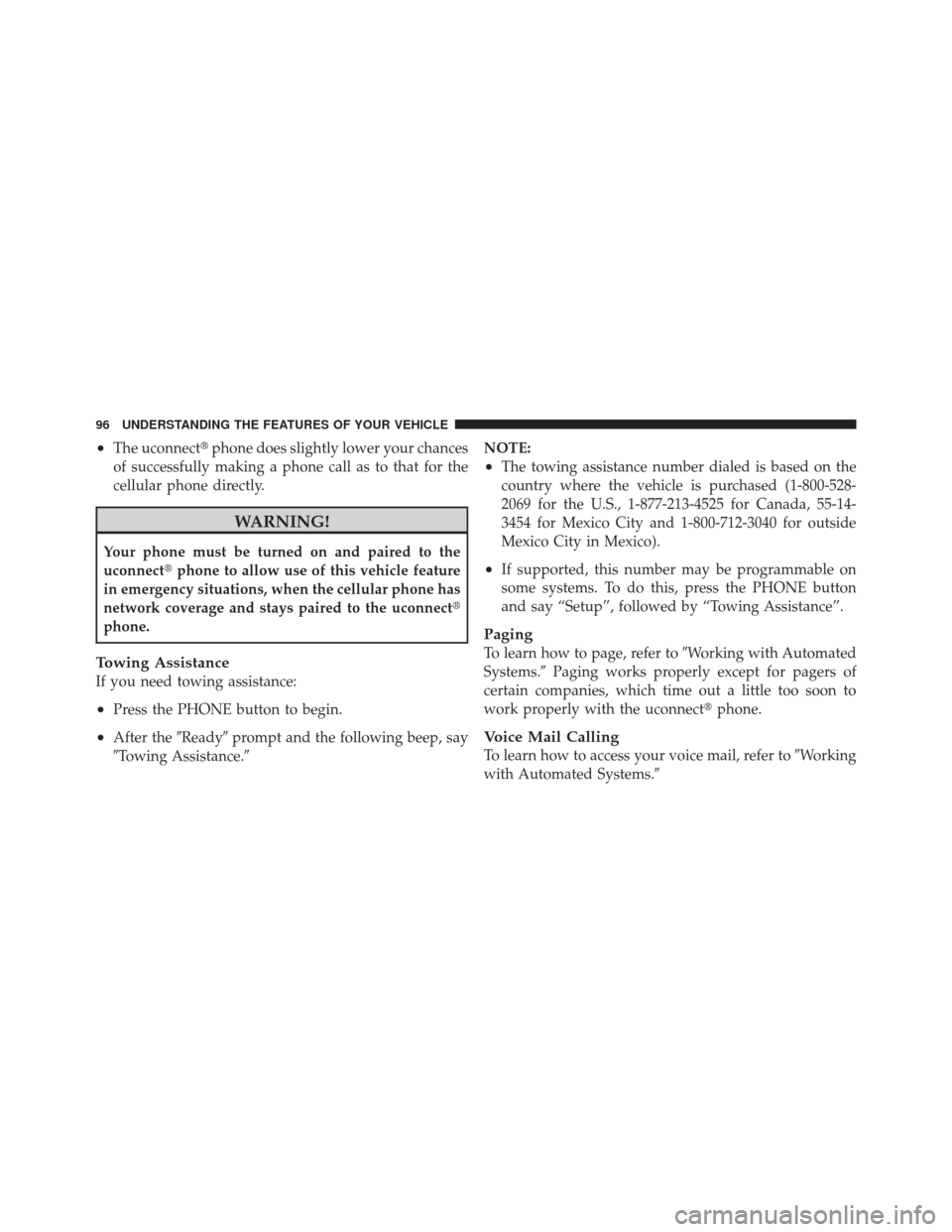Page 28 of 410
2. Closeness to a radio transmitter such as a radio station
tower, airport transmitter, and some mobile or CB radios.
Transmitter Battery Service
NOTE:Perchlorate Material – special handling may ap-
ply. See www.dtsc.ca.gov/hazardouswaste/perchlorate.
The recommended replacement battery is CR2032.
1. If the RKE transmitter is equipped with a screw,
remove the screw. With the RKE transmitter buttons
facing down, use a flat blade to pry the two halves of the
RKE transmitter apart. Make sure not to damage the
elastomer seal during removal. 2. Remove and replace the battery. Avoid touching the
new battery with your fingers. Skin oils may cause
battery deterioration. If you touch a battery, clean it with
rubbing alcohol.
Separating RKE Transmitter Halves
26 THINGS TO KNOW BEFORE STARTING YOUR VEHICLE
Page 43 of 410

WARNING!
•A belt that is buckled into the wrong buckle will
not protect you properly. The lap portion could ride
too high on your body, possibly causing internal
injuries. Always buckle your belt into the buckle
nearest you.
• A belt that is too loose will not protect you as well.
In a sudden stop you could move too far forward,
increasing the possibility of injury. Wear your seat
belt snugly.
6. To release the belt, push the red button on the buckle.
The belt will automatically retract to its stowed position.
If necessary, slide the latch plate down the webbing to
allow the belt to retract fully.
WARNING!
A frayed or torn belt could rip apart in a collision and
leave you with no protection. Inspect the belt system
periodically, checking for cuts, frays, or loose parts.
Damaged parts must be replaced immediately. Do
not disassemble or modify the system. Seat belt
assemblies must be replaced after a collision if they
have been damaged (bent retractor, torn webbing,
etc.).
Rear Center Lap/Shoulder Belt Retractor Lockout
This feature is designed to lock the retractor whenever
the rear seatback is not fully latched. This prevents
someone from wearing the rear center lap/shoulder belt
when the rear seatback is not fully latched.
NOTE:
•If the rear center lap/shoulder belt cannot be pulled
out, check that the rear seatback is fully latched.
2
THINGS TO KNOW BEFORE STARTING YOUR VEHICLE 41
Page 57 of 410

injure you if you are not seated properly, or if items are
positioned in the area where the side airbag inflates. This
especially applies to children.
NOTE:If your vehicle is equipped with left and right
side curtain air bags, do not install a clothing bar
mounted to the coat hooks (or similarly mounted). A
clothing bar will impede the proper performance of the
bags.
•When the ORC and the impact sensors detect a
collision requiring the Driver Inflatable Knee
Blocker, it signals the inflator unit. A quantity of
nontoxic gas is generated to inflate the Driver Inflat-
able Knee Blocker. The Driver Inflatable Knee Blocker
inflates rearward towards the driver’s knees to help
protect the knees and position you for the best inter-
action with the front airbag. The Driver Inflatable
Knee Blocker fully inflates in about 50 milliseconds, this is only about half of the time it takes you to blink
your eyes. It then quickly deflates while helping to
protect the driver’s knees.
•The
Knee Impact Bolsters help protect the knees, and
position everyone for the best interaction with the
front airbag.
The front passenger seat assembly contains critical com-
ponents that affect the front passenger airbag deploy-
ment. Correctly functioning front passenger seat compo-
nents are critical for the Occupant Classification System
(OCS) to properly classify the front passenger and calcu-
late the proper airbag deployment. Do not make any
modifications to the front passenger seat components,
assembly, or to the seat cover.2
THINGS TO KNOW BEFORE STARTING YOUR VEHICLE 55
Page 70 of 410

provide add-on tether strap kits for some of their older
products. Tether anchorage kits are also available for
most older vehicles.
Because the lower anchorages are to be introduced to
passenger-carrying vehicles over a period of years, child
restraint systems having attachments for those anchor-
ages will continue to have features for installation in
vehicles using the lap or lap/shoulder belt. They will also
have tether straps, and you are urged to take advantage
of all of the available attachments provided with your
child restraint in any vehicle.
NOTE:When using the LATCH attaching system to
install a child restraint, please ensure that all seat belts
not being used for occupant restraints are stowed and out
of reach of children. It is recommended that before
installing the child restraint, buckle the seat belt so the
seat belt is tucked behind the child restraint and out of
reach. If the buckled seat belt interferes with the child restraint installation, instead of tucking the seat belt
behind the child restraint, route the seat belt through the
child restraint belt path and then buckle it. This should
stow the seat belt out of the reach of an inquisitive child.
Remind all children in the vehicle that the seat belts are
not toys and should not be played with, and never leave
your child unattended in the vehicle.
Installing the Child Restraint System
We urge you to carefully follow the directions of the
manufacturer when installing your child restraint. Many,
but not all, restraint systems will be equipped with
separate straps on each side, with each having a hook or
connector, and a means for adjusting the tension in the
strap. Forward-facing toddler restraints and some
rearward-facing infant restraints will also be equipped
with a tether strap with a hook and means for adjusting
the tension in the strap.
68 THINGS TO KNOW BEFORE STARTING YOUR VEHICLE
Page 81 of 410
MIRRORS
Inside Day/Night Mirror
A two-point pivot system allows for horizontal and
vertical mirror adjustment. Adjust the mirror to center on
the view through the rear window.
Headlight glare can be reduced by moving the small
control under the mirror to the night position (toward the
rear of the vehicle). The mirror should be adjusted while
set in the day position (toward the windshield).
Outside Mirror — Driver Side
Adjust the outside mirror to center on the adjacent lane of
traffic, with a slight overlap of the view obtained on the
inside mirror.
Adjusting Rearview Mirror
3
UNDERSTANDING THE FEATURES OF YOUR VEHICLE 79
Page 84 of 410

uconnect�phone — IF EQUIPPED
NOTE: The sales code RER and REU radios contain an
integrated uconnect� phone. Refer to your “Navigation
User’s Manual” for uconnect� phone operating instruc-
tions for these radios. Radio sales code can be located
on the lower right corner of the Radio faceplate.
uconnect� phone is a voice-activated, hands-free, in-
vehicle communications system. uconnect� allows you to
dial a phone number with your cellular phone using
simple voice commands (e.g., �Call”�“Mike” �”Work� or
�Dial” �“248-555-1212�). Your cellular phone’s audio is
transmitted through your vehicle’s audio system; the
system will automatically mute your radio when using
the uconnect� phone.
NOTE: The uconnect� phone requires a cellular phone
equipped with the Bluetooth�� Hands-Free Profile,�Ve r -
sion 0.96 or higher. See the uconnect� website for sup-
ported phones. For uconnect�
customer support, visit the following
websites:
•www.chrysler.com/uconnect
•www.dodge.com/uconnect
•www.jeep.com/uconnect
•or call 1–877–855–8400
uconnect� allows you to transfer calls between the sys-
tem and your cellular phone as you enter or exit your
vehicle and enables you to mute the system’s microphone
for private conversation.
The uconnect� phone is driven through your Bluetooth�
“Hands-Free Profile” cellular phone. uconnect� features
Bluetooth� technology - the global standard that enables
different electronic devices to connect to each other
without wires or a docking station, so uconnect �phone
works no matter where you stow your cellular phone (be
82 UNDERSTANDING THE FEATURES OF YOUR VEHICLE
Page 98 of 410

•The uconnect�phone does slightly lower your chances
of successfully making a phone call as to that for the
cellular phone directly.
WARNING!
Your phone must be turned on and paired to the
uconnect� phone to allow use of this vehicle feature
in emergency situations, when the cellular phone has
network coverage and stays paired to the uconnect �
phone.
Towing Assistance
If you need towing assistance:
•Press the PHONE button to begin.
•After the �Ready�prompt and the following beep, say
�Towing Assistance.� NOTE:
•The towing assistance number dialed is based on the
country where the vehicle is purchased (1-800-528-
2069 for the U.S., 1-877-213-4525 for Canada, 55-14-
3454 for Mexico City and 1-800-712-3040 for outside
Mexico City in Mexico).
•If supported, this number may be programmable on
some systems. To do this, press the PHONE button
and say “Setup”, followed by “Towing Assistance”.
Paging
To learn how to page, refer to
�Working with Automated
Systems.� Paging works properly except for pagers of
certain companies, which time out a little too soon to
work properly with the uconnect� phone.
Voice Mail Calling
To learn how to access your voice mail, refer to �Working
with Automated Systems.�
96 UNDERSTANDING THE FEATURES OF YOUR VEHICLE
Page 111 of 410
Voice Commands
Primary Alternate(s)
language
list names
list phones
mobile
mute
mute off
new entry
no
pager
pair a phone
phone pairing pairing
phonebook phone book
previous
record again
redialVoice Commands
Primary Alternate(s)
return to main menu return or main menu
select phone select
send
set up phone settings or phone set up
towing assistance
transfer call
uconnect� Tutorial
try again
voice training
work
yes
3
UNDERSTANDING THE FEATURES OF YOUR VEHICLE 109